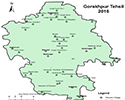
Monitoring of arsenic in groundwater of adjoining areas of Gorakhpur District (U.P.), India.
Abstract
Arsenic contamination is an enormous worldwide problem. Groundwater arsenic contamination and sufferings of people have been reported in 20 countries in different parts of the world. The magnitude is considered highest in 5 Asian countries and the severity is in order of Bangladesh> India> Mangolia > China> Taiwan. The contamination of drinking water supplies with natural Occurring arsenic is major health problem. The paper deals estimation of arsenic in groundwater of Gorakhpur district. For this purpose, total 36 study sites were selected in urban as well as in rural area of the district, further the samples were collected from shallow bore well as from the deep bore wells. It was concluded that 5 areas are under high risk zone of arsenic, 5 areas are at the low risk and 26 areas which are monitored are in the safe zone of arsenic. High risk areas are crossing the permissible level of arsenic consumption according to WHO.
Keywords
Full Text:
PDFReferences
Kumar S, Pandey. G, Sharma. A, “Assessment of Arsenic in Groundwater in Gorakhpur District, Uttar Pradesh, India‟, M. Tech. Dissertation, Department of Civil Engineering, M. M. M. Engineering College, Gorakhpur, U.P., India (2011):766-770
Verma S.S. and Singh V.K. “Ramgarh Tal; A Dwindling Natural Hritage,” in A.K. Dubey & A.K. Pandey (Eds) Archaeological and Cultural Heritage of Purvanchal, Pratibha Prakashan, Delhi, (2009): 437-454.
Verma S.S. “Urban Land Use Inventory: Through Aerial Photo Interpretation Technique” Shivaya Publication, Gorakhpur, U.P., India, (1986): 5
Srivastava S, Dwivedi A.K “Biological Wastes: The Tool for Biosorption of Arsenic.” J Bioremed & Biodeg 7.1 (2015): 323.
Dwivedi AK, Srivastava S, Dwivedi S, Tripathi V. “Natural Bio-Remediation of Arsenic Contamination: A Short Review.” Hydrology: Current Research. 6.1 (2015): 186.
Dwivedi, A.K. “Arsenic in Groundwater: An Issue Beyond Boundary” In: Biodiversity Conservation & Sustainable Development (Ed. S. Domonic Rajkumar and J.K. Lal), Centre for Biological Research, Puthalam, Tamil Nadu, India: (2013): 30-43.
Smith M. M. H., Timir H., Protap C., Chakraborty D. K., Xavier S., and Smith, A. H. “A dugwell program to provide arsenic-safe water in West Bengal, India: preliminary results.” J. Environ. Sci. Health A Tox. Hazard. Subst. Environ. Eng. A38, (2003): 289–299.
Ahmed A. A., Alam M. J. B., and Ahmed, A. M. “Evaluation of socio-economic impact of arsenic contamination in Bangladesh.” J. Toxicol. Environ. Health Sci. 3 (2011): 298–307.
Bhatia S, Balamurgan G, Baranwal A. “High arsenic contamination in drinking water hand-pumps in Khap Tola, West Champaran, Bihar, India Front. Environ.”(2014). Sci https://doi.org/10.3389/fenvs.2014.00049.
DOI: https://doi.org/10.21746/aps.2018.7.4.23
Copyright (c) 2018 Annals of Plant Sciences

This work is licensed under a Creative Commons Attribution-NonCommercial-NoDerivatives 4.0 International License.


